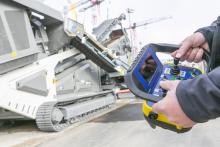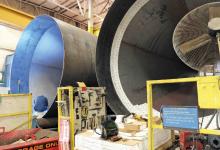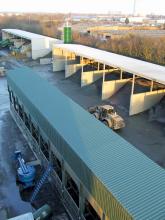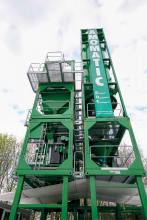Italian firm
The company has offered a number of solutions for utilising RAP in asphalt mixes for batch plants over the years but now believes it has advanced the technology a further step ahead with its innovative Master Tower.
The plant is designed to cope with a high percentage of recycled asphalt pavement (RAP), as much as 100% for some mixes. However, this has necessitated rethinking the way asphalt is produced. Marzio Ferrini is head of product marketing at Marini and commented, “The technology of the Master Tower is completely different from the past.”
Previous asphalt plants using RAP in the feed have featured counterflow designs or parallel drums. However, these designs have their limitations with regard to the quantities of RAP they can use in the feed.
Instead, this innovative batch plant design features its two drums mounted end to end. The first drum is for drying the virgin aggregates and is heated by a burner. An internal tube carries the heat through the virgin aggregate drum, ending before it reaches the end of the drum. The hot gases then circulate through the drum, before passing through the heat exchange systems to the second drum where the RAP is added. With this design, there is no direct heating of the bitumen. The plant can use a mix of virgin materials plus RAP, or produces mixes only from recycled materials.
The first plant is being installed at a site in France for a customer, having undergone extensive testing at the Marini factory in Italy. Marini will exhibit a 1:7 scale model of the plant at the bauma exhibition in Munich in April.
The tests carried out at the factory have included production of numerous asphalt mixes, using a variety of feed materials. These feed materials have been tested before production to determine their properties accurately, with the asphalt produced also being subjected to numerous quality checks.
But this new approach has required considerable research and development work and Ferrini said, “It was such a difficult project, we could not develop it by ourselves.”
As a result, the University of Bologna also assisted in the development work, with input also from some independent companies and the regional government. With such a radical change in design, numerous simulations were carried out. These simulations have helped understand the way materials behave in the drum and Ferrini said, “We reduced the time to market by the use of software.”
The location and spacing of the flights inside the aggregates drum and the RAP drum was modelled so as to optimise material flow and to ensure the materials received the most efficient heat distribution. Sensors were also fitted at various points in the drums, heat transfer system, mixer and baghouse, to monitor temperatures throughout the plant during operation. Bologna University also helped with the study for the flight positioning, as well as assisting in evaluating the temperatures recorded by the sensors inside the plant.
This new plant has been developed to meet a need to optimise the use of RAP in asphalt mixes which is strong in the road building sector. Ferrini explained that RAP provides a cost-effective source of material for road builders and is also environmentally beneficial but it has to allow the production of high-quality asphalt. He said that in many instances the quality of the stone in the RAP is of premium quality, something that can be determined by testing, helping boost the quality of the output. What is crucial is ensuring that the asphalt manufacturing process is optimised when using RAP, while additives may also be required to address potential issues with ageing.
Heating RAP properly is crucial as too much heat or a direct flame can result in the valuable bitumen content being burned off, and also generating more fumes. Ferrini said that by using a single burner in the first drum to heat the virgin feed material only, there is no risk of overheating the RAP entering the second drum. Heat from the first drum is said to be transferred efficiently to the second drum, allowing the RAP to be heated effectively. Meanwhile, heavily insulated piping from the end of the second drum then reroutes remaining heat back to the first drum, further increasing overall efficiency. And both drums are also heavily insulated to retain heat and reduce losses in the system.
The heat recirculation system involves patented technology and the plant has a 6tonne mixer that allows a high percentage of RAP to be mixed in the feed.
Because the plant relies on a single burner only, it requires less maintenance but perhaps more importantly, it also uses considerably less fuel than a plant with a similar output that is features twin burners. According to Ferrini, the Master Tower uses up to 30% less fuel than a comparable twin burner plant, leading to substantial savings in running costs.
Another key feature of the Master Tower is its filtration system, which is designed to minimise dust emissions. Each drum has its own pre-separation system to extract dust and fumes and direct these to the baghouse for filtration.
Because the temperatures in the second drum are optimised to ensure that no bitumen is burned off, emissions are further reduced. The plant has a high-capacity filter bag system is designed to remove dust and Ferrini said, “All the fumes produced in asphalt production are treated.”
According to Marini, this plant has amongst the lowest emissions of any asphalt production facility yet built, easily meeting existing requirements.
The control system is crucial to the new plant. Ferrini explained that around 50% of the development work carried out on the plant was focussed on the control system. He said, “It’s a totally new software.”
The sophisticated software offers versatility, allowing the user to switch recipes from batch to batch. The design of the plant allows it to operate with just virgin materials, or up to 100% RAP in the feed. In theory the plant could be used to produce a base course featuring a 90% RAP content, followed immediately by a wearing course featuring a 90% virgin materials content.
Measuring 45m high and 25m long for site use, the plant also features storage silos located to the side. However, Ferrini commented that given its 300tonnes/hour output, the plant is comparatively compact.










